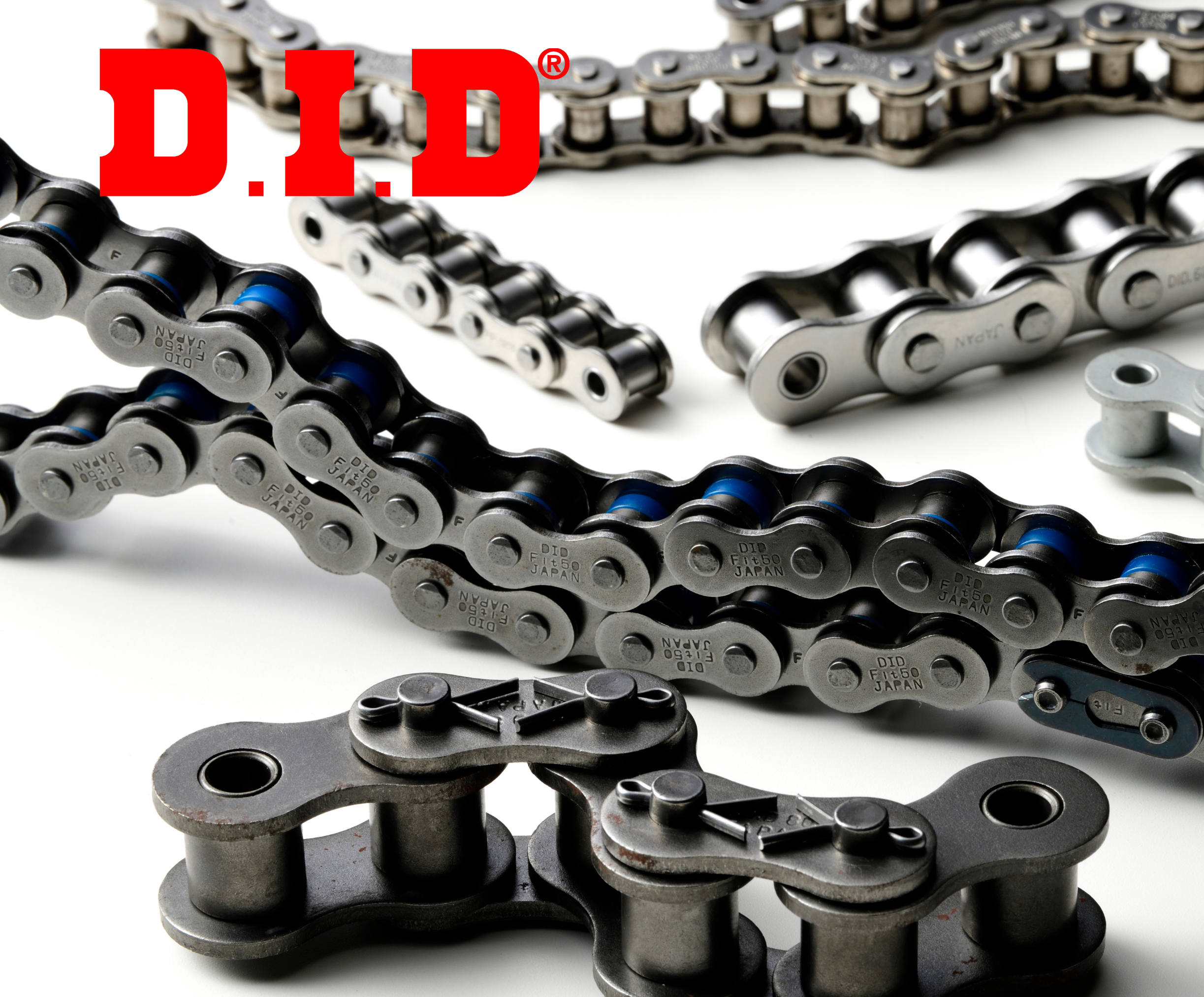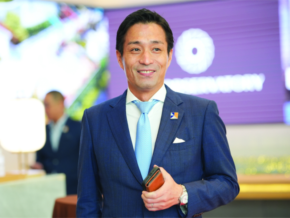Business Talk with Elbert Cuenca, Steak Room Concepts
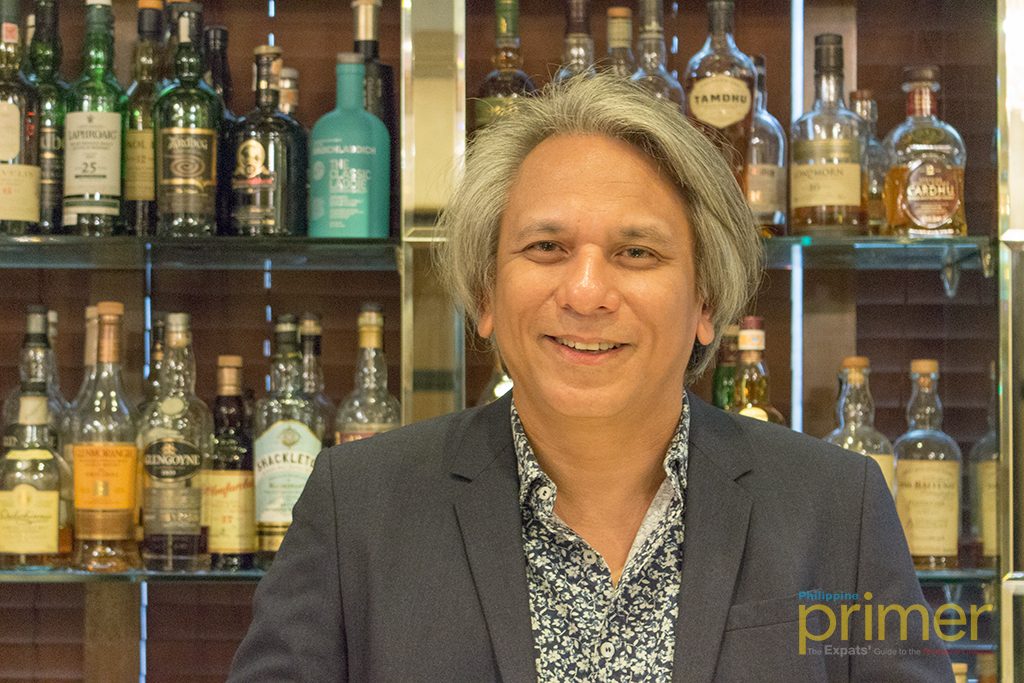
Elbert Cuenca has been involved in the restaurant industry for almost 23 years. He used to be involved with Apple computers, which means he knows both his tech and his food. He’s happily married, likes to travel, and likes to ride his bike. He used to be a part of the team that ran Ramen Yushoken, Mendokoro Ramenba, and Kazunori, and is now focusing on his original business venture: Steak Room Concepts.
Can you tell us about how you got into the restaurant scene?
My father was the president of Furusako Japanese Restaurant, which started in 1977. I believe that’s where it started because I grew up knowing that our family had a restaurant business, although it wasn’t my father’s main business. Having that around you introduces the idea that maybe one day, you might be in the restaurant business.
I was once in charge of Club Mar’s marketing, which was my first official exposure to the hospitality industry. In 1995, I was eventually asked by my cousins who were taking over Furusako to help them do the marketing for this new Japanese restaurant called Zen.
I became a consultant for various clubs and restaurants after I left the family business in 2000 before I became involved in technology. I went back to the restaurant industry in 2002 when I put up Restaurant 12 in Greenbelt. When it closed down in 2004, that’s when I learned one of the most painful lessons of the restaurant industry: failure.
From there, I went back to technology and took on the odd job of becoming what you would call a “Personal Mac Tutor.” I was teaching people one-on-one on how to use their computers. I started meeting a lot of people as a Mac tutor, including my good friend, the late Archie King. Archie King owns the Victoria Court Group of Companies. He was the one I pitched the idea of a steak restaurant to. He became both my partner and mentor, and we eventually found this space and opened Elbert’s Steak Room in 2007.
What made you decide to go back into the restaurant business after all those years working in the tech industry?
I had an innate desire to be of service to people. I felt that way as a Mac tutor: I was helping them out, giving them knowledge and education; but I felt it was too limited because I was only dealing with one person at a time. Not that I was getting tired of it, I enjoyed what I was doing; it’s just that I felt I wanted [to do] more.
I’ve never taken my eye off the restaurant industry throughout that time. Every day you eat out, you see things. You see new restaurants, you see what’s happening in the restaurant industry. I would be keen on observing what everyone else was doing and what the trends were abroad and I had formed this idea for a restaurant in my head. I told myself if I was to open a restaurant again, I should take the lessons I learned from losing a restaurant. I felt like the king of the world at that time and I think this is one of the reasons why I failed: I was a bit too cocky, too brazen, and too big-headed about it.
I decided to take lessons from that failure and did the exact opposite. From being a flashy restaurant, I decided to do a discreet restaurant. From being a restaurant that was highly conceptual, I went with something basic. Instead of doing something completely ultra modern, I did something that’s a little more contemporary and traditional. I went from high visibility to high profile. I would also be more humble because I felt a lot of those great things combined were the reasons why I had failed in the first place.
Ten and a half years later and this is what you have: a successful yet discreet restaurant that caters to a very discerning market.
“I was a bit too cocky, too brazen, and too big-headed about it.”
– on opening his first restaurant
What do you think should go into creating a restaurant that serves good food and has a good following?
You have to figure out why people visit your restaurant in the first place. Once you have a grasp of why people come to you, you will know what you need to do to keep them coming back.
Your objective is to fulfill what it is that they are looking for. If they came to you for an experience that includes a high level of cuisine and service, then you must be able to meet those expectations.
I tell all my staff the same thing: our mission is not to make money out of people, our mission is to make happy customers. If every customer that comes to our restaurant leaves with a smile on their face, then we would have accomplished our mission.
What do you think are the qualities that someone should have to be a restaurateur?
There has to be an innate desire to be of service; that really is number one. It has to be the opposite of being a show-off and a boss.
A lot of restaurants fail because a lot of restaurant owners believe that the restaurant is the ultimate way of showing off their power, position, and wealth. A better way of doing that might be to buy a Ferrari, stand beside it every day, and say “I’m rich, I’m powerful, and I can afford this car.”
This [industry] is the exact opposite. You have to have an innate desire to be of service to people. You have to be humble and modest about it. You have to make sure it doesn’t get to your head.
What exactly is Steak Room Concepts?
When I envisioned this business, I decided to simplify everything that I had done before. Instead of something grand, I decided to be something more basic; something that allows me to focus and take care of what we need to do.
If I had to put up a restaurant that would have a hundred dishes, I will not be able to make a hundred good dishes because there’s no focus. You cannot focus on a hundred meals, so I decided to simplify and go with steak.
I chose steak because it was something I grew up with. It is something I have always enjoyed and loved, and I always wanted a great steak. I felt that nobody in this country was able to fulfill my desire for a great steak. Even in my travels abroad, there were a lot of disappointing steaks; it’s another reason why I opened the Steak Room.
The Steak Room was the opposite of what Restaurant 12 was. At Restaurant 12, we had this concept of hosting guest chefs that would change on a regular basis. We would have a guest chef for a week or one or two weekends, while some would stay for a month. The problem was there was no focus on any particular cuisine. Our customers would come back trying to look for a dish they had last week only to realize it was no longer being served.
I decided I would do something that would last a long time. I did not want something that would only be around for a couple of years and close up after I made some money off of it. I wanted to have a restaurant that would be a staple, an institution that would last as long as I lived. I told myself that f I can focus on a single concept, which in this case is steak, I have to be good at making the steak because there wasn’t anything else I could brag about. I figured out that if that’s all I do, how can I not be good? It’s a single discipline, which is also one of the reasons why I did it.
We called it Steak Room Concepts because that was the business at hand. It’s literally a steak room because it’s a small place. You wouldn’t call it a steakhouse, so we called it a steak room.
I went with a literal approach to naming the restaurant because I didn’t want to have people figure out what the name of the restaurant meant. I also put my name on the line like a personal endorsement.
I believe most of the great institutions around the world would have the owner’s own endorsement by putting their name on the sign. So Elbert’s Steak Room is my personal offering of what a steak experience should be.
What gave you the confidence to put your name in the name of the restaurant?
I wanted to tell people and remind myself that this is a sincere personal offering. When you put your name on something, it’s like telling people “I’m there” and this person is trying to serve you something, like Antonio’s (Chef Tony Boy Escalante) and Sonya’s (Sonya Garcia) in Tagaytay, or Peter Luger’s Steak House (Peter Luger) in New York.
I always felt that it was the way to approach service industry: to literally put your name on the line and say that if this fails, it’s Elbert who looks bad and not the restaurant. If you do it right, it’s “Elbert” who looks good because it was him who said he would offer all of this to you.
“There has to be an innate desire to be of service.”
– on what it takes to be a successful restaurateur
After Elbert’s Steak Room, you had a couple more restaurants.
When I first put up the Steak Room, the schedule was we’re open from Monday to Saturday for dinner. We were supposed to be purely for dinner. I thought the daylight changed the mood and the ambiance of the restaurant so much that you would not be able to have the experience I imagined for this restaurant.
There was a clamor for lunch, but I cannot offer steak for lunch because it takes too long to prepare and people are in a hurry during lunch. It would also be too expensive for lunch and I didn’t want to be accused of being too expensive. Combine that with a different ambiance and there wasn’t a way for me to charge the same price. It’s almost like watching a stage play, but instead of mood lighting, you make it very bright: the whole mood is lost you cannot enjoy it for what it should be.
Being a steak restaurant, we had a freezer full of steak trimmings: end cuts, tips from tenderloins, etc., that can’t be served as a steak. I realized we could take these trimmings, make a menu out of them, and serve it as lunch for businessmen. That’s when we started to use steak in a different way.
We made pasta dishes, sandwiches, and hamburgers from the meat. One of the products that we ended up doing was a cheesesteak sandwich, which is similar to what they do in Philadelphia. We looked for a bread supplier and played around with the idea of putting great meat into a steak sandwich. We would have people, customers who were alumni of Wharton [School of the University of Pennsylvania] coming in saying “We heard you have a cheesesteak sandwich.” Growing up in Philadelphia, they (the alumni) were all craving for a cheesesteak sandwich.
That was where the idea of putting up a cheesesteak sandwich stand came about. This was in 2009, and it gave birth to Elbert’s Cheesesteak Sandwiches, a sandwich stand in Rockwell.
We had a good five-year run serving cheesesteak sandwiches, and I didn’t believe in expanding the restaurant at that time. I believed that if I was to open another restaurant, I should do something different. I did not want to do two of the same restaurant; it had to be something independent, something unique, but still with a single concept.
During that time, a friend of mine who was also my customer approached me and asked if we could do a restaurant business together. I said “Sure. Whatever you have, let’s do it together.” We went through several different ideas (pizza being one of them) when one day we were hit with an idea: ramen. It was a time that ramen was becoming a craze not just here but in Japan and the U.S. I told him “I’ll help you.”
I wouldn’t mind doing it, but I admit I was a bit apprehensive about it because it wasn’t my idea. However, with my willingness to help others, I had no problem being involved in helping someone who needed my services. He eventually found a way to bring in a ramen business from Japan: Yushoken.
We found a partnership with a restaurant group in Japan that had hundreds of restaurants under their name. Many of them served ramen, but they also had sushi restaurants, those that served curry, and others. They also had a lot of champion ramen chefs under their wing.
The idea was for them to come to Manila, with Ryan Cruz and me as their local partners. We agreed to a joint venture partnership and found a location in Alabang. The agreement was they would be the ones to run the business while we guided them on how to do it in the Philippines.
We were blown away during food tastings, and I then became very invested in Yushoken. The president of that company, however, passed away just before we could set up shop in Alabang. We had to change the mode of the business when that happened.
We were no longer a joint venture. They offered us a business franchise since Ryan and I have done a lot of work (sourcing, looking for a location, etc.). They would help the same way by teaching us how they would have gone about the business if they were the ones to run it. It was their way of honoring their late president, who had this as his last project before he passed away. That’s when we decided we would pursue it.
We invited our other friends to invest because we were no longer a joint venture and put up Ramen Yushoken. I was directly involved in running Yushoken. I co-managed it with Ryan, who had no experience in the restaurant industry. He was learning about it along the way as we ran the business together.
I wanted to grow the business organically so we decided not to branch out at first. We wanted to create a sort of “legend” for ourselves. I would throw in ideas like not buying advertisements to make people come to us for the food, and everyone liked those ideas.
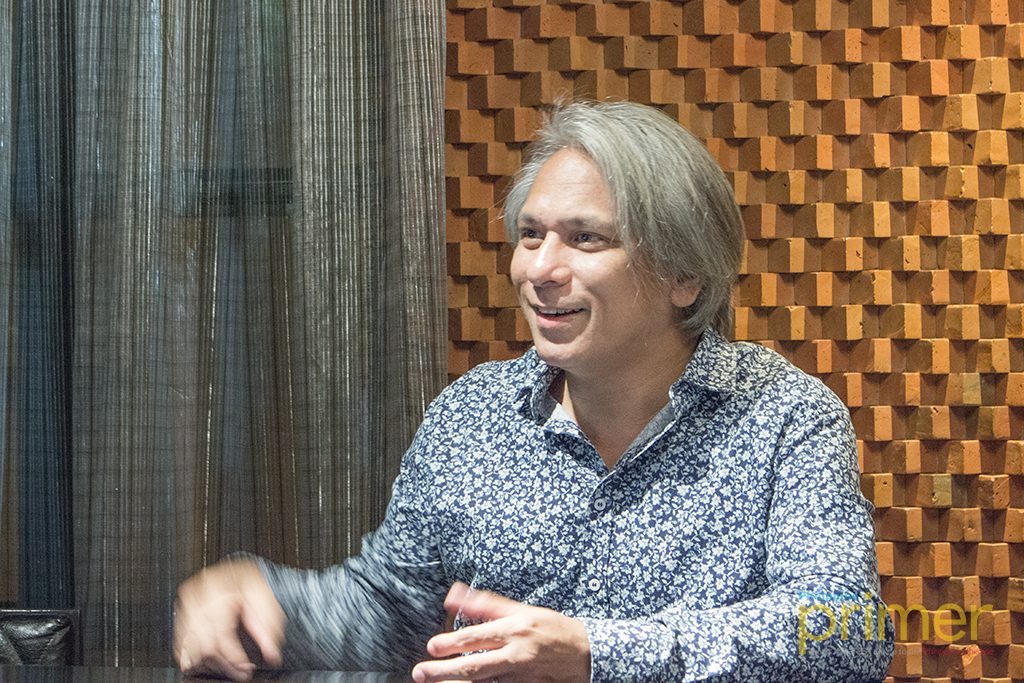
We eventually ran into a production issue. We weren’t making enough broth at first so we invested in a factory, which then produced too much of it. We had to expand and opened Mendokoro, which was like a junior version of Yushoken, except it was the kind of ramen shop we initially wanted: we wanted a bar, we wanted people to buy tickets at the door before coming in, and we wanted people to have a more serious ramen experience.
We wanted them to focus on the food and have a personal experience. That’s why there were no beverages, no music, and no dessert: it was just ramen and water. We were able to make this dream a reality because of the popularity of Yushoken. Even then, we were still producing too much soup, which led to us opening a Yushoken in Cebu.
We decided to do two different names because we didn’t want to dilute the name of our restaurant in Alabang. We felt that if you put up two Yushokens in the same island, neither would be as special as it ought to be.
Cebu, however, was a different story. We had to take the popularity and reputation we had in Alabang. We had to tell them who we were, and that’s what led to the branch in Cebu carrying the name Yushoken. We also didn’t mind because it was on a different island.
That business is now going into a fourth branch: a Mendokoro in BGC. This was when I started thinking “Okay, I’ve done my part. It’s a successful business, but it’s growing beyond what I liked to do.” The Steak Room was still a small operation with a single branch. I had also moved my sandwich shop from Rockwell to Alabang and back again because it wasn’t doing well in Alabang.
I decided if I’m going to go back and take care of this business (Steak Room Concepts), I need to be in it 100%. I cannot run two businesses [at the same time], so I told my partners I was resigning. This was around the time we were about to open Kazunori, a restaurant we did with the chef of Yushoken. He really wanted to put up a Japanese restaurant in the Philippines that would not compete with Yushoken. I was involved with Kazunori until it opened.
I owed it to my investors to grow the Steak Room. It was doing very well, but I wanted to show them that we could do the same thing we did in Yushoken and apply it to the Steak Room and do a little bit of expansion.
Now, we’re bringing back Elbert’s Sandwiches to Rockwell. There’s also a new food hall opening in Rockwell called The Grid where I will be putting up a steak-teppan stall, a marriage of my background in steak and Japanese food.
I also took the mezzanine space from Mendokoro in BGC and decided to bring my experience from my whiskey and cigar bar there. I’ll be putting up a non-smoking bar that serves gin tonic and single-malt whiskey called The Upstairs Bar.
Along the way, I found a new project to work on. I met a chef, a Filipina who worked at Joël Robuchon in Paris, London, and Singapore, who wanted to put up a restaurant. I tried their food and needless to say I was impressed. I’m going to be partnering with her for a new French restaurant that will be opening somewhere in Legaspi Village this year.
What separates your restaurants from others with a similar concept/theme?
We’re probably the smallest steakhouse anywhere, and that’s by design: I want to be able to focus and take care of our customers. The fewer tables you have, the easier it is to be attentive to your customers.
We’re also the only steak-centric steakhouse, i.e. we don’t offer other dishes. Other steakhouses serve seafood and pasta, but we focus solely on steaks. We do have seafood on the side — it’s in the fine print of our menu — just in case, but it’s not something we highlight.
This business has grown from a dinner-only steak restaurant to one that serves lunch and dinner. The restaurant is completely different during lunch. It’s very casual: I remove all the tablecloths and put paper napkins and paper plates because it’s daytime. The price of lunch is about a third or a quarter that of our dinner because it’s an executive lunch. We don’t serve steak, but we serve prime rib for anyone who wants to have something close to a steak.
The second floor was offered to me about four years ago. This used to be occupied by a travel agency that was downsizing; I took the opportunity to expand the business and put up this huge private room that seats about 15-16 people.
It’s completely private from the restaurant because it’s on another floor and we have an adjacent cigar and single-malt whiskey bar. We played off of steak, a manly dish, and continued with cigars and single-malt whiskey, which were also very manly.
That is how this business has grown: a restaurant that has both lunch and dinner, and a cigar and single-malt whiskey bar called the Riedel Room, named after the Austrian glass manufacturer. Both have completely different markets, but they all exist in one place.
What were the challenges you ran into when you opened Elbert’s Steak Room?
The biggest challenge was not having enough funds to build this restaurant. I really needed to open [the Steak Room] as I already had the beef shipped from the US. It was scary because they will go bad if I didn’t serve them soon. The problem I had was the restaurant wasn’t completed and I couldn’t [complete it] because I ran out of funds.
What I did was I decided to partially open the restaurant. I had three tables and enough money to buy linen, plates, glasses, and cutlery for all three, so I opened with just three tables. My bar counter had no marble on top, the restroom wasn’t functioning yet, so customers had to go to the kitchen to wash their hands. There was a communal bathroom outside if they want to use the toilets, so we were half-baked when we opened, but I had allowed customers to come. I didn’t even have money to put up a sign or have complete lighting.
We are a restaurant that wasn’t even fully operational and we had customers every day. The beauty of my past was that everyone I had met tutoring became my customers. They came from different industries: doctors, housewives, business owners, lawyers, bankers, etc. One person invites another person, and word of mouth traveled. This was when I realized I didn’t need to advertise; I didn’t even have to put up a sign.
This was a restaurant that grew by itself. I would use the money I earned from each table to buy what I needed to complete the restaurant. I bought more plates, the marble for the bar, finished building the bathroom, and added more lights and pieces of furniture. This was in July 2007, and we completed the restaurant in December. We had no profits to speak of by the end of the year because we invested everything back to the restaurant.
Every customer that came during those days saw us grow, and they grew with us. They’re like family: they saw us transform from an incomplete restaurant into what we are today. We tell them that they are our partners; them eating at the Steak Room helped us finish the restaurant.
We didn’t have a sign because we didn’t have money for a sign. I also didn’t know where to put up a sign even if I had the money for it. I had a logo which I designed, but I was worried that if I put up a sign, we might get people who didn’t understand what we were about. They might get the wrong impression and be shocked at our prices. We liked word of mouth because they would tell people to prepare a certain amount instead of being surprised at our menu.
I also wanted to keep the experience of eating here for the first-time. If I changed it, I would be depriving those people of the same experience as those came here before; it would be unfair to them.
What are your plans for the foreseeable future?
A lot of what I do is organic. I don’t look for projects. I don’t push myself to do more. I take opportunities as they come along. The desire is not to make money out of the food; the desire is to share this food with as many people as we can.
This was the case with the French restaurant. I met the chef, I enjoyed her food, and I told her that I believe the Filipino market deserves to eat her food. Somebody had just offered me a restaurant, and all I had to do was renovate and change the name.
I like to think I also represent the market I want to serve. That’s how I felt about the Steak Room. I’ve been looking for something like this but it didn’t exist, so I created it and I’m happy to see that people agree with me. The same goes for sandwiches when we were in Rockwell and the ramen.
You know how things just fall into place? The Upstairs Bar in Icon? That was also by accident. Mendokoro didn’t need the mezzanine space, so I put a bar there. I like to go out for a nightcap before I go home from BGC, but I don’t know where to go. So this is me fulfilling my own personal desires and needs as well.
All my projects are projects that fall into place. They are opportunities that present themselves. I don’t pursue projects and force the issue. I pursue them because everything falls into place.
How would you describe your management style?
I am very casual. I’m not structured at all. I believe in things running naturally and organically.
When I need to hire people, my interview normally lasts five minutes. After that, I tell them they can start the next day. For me, the only way to know if somebody can work for me is if they can do the job, and I can’t tell that just by talking to you or looking at your resume.
I’m more like a friend to my staff. I don’t want them to look at me as a boss. I’d rather they look at me as their mentor, somebody who leads them.
I’m also very idealistic. My management style is to share why and how I do things. One of the biggest lessons I always teach is that money should never be your motivator.
If you keep working for money, your customers will know that you’re only after their money, and they will not come back. When they see that you’re not after their money, they will feel that you’re sincere in trying to serve them. If they tip you, that’s great, but don’t expect it. It’s how we elevate and maintain our service standards.
Who are the people you look up to?
I would say Archie King. He was my partner and the first one who invested in me, though I didn’t realize it at first.
When we first opened the business, I asked him to put in more money so we can open the restaurant, but he said no. He wanted to teach me that this is what business is. He told me he had “given you as much as I think I should give to the business and you need to maintain the majority stake of this business. If I put more money than you, then I’ll own your business–and that’s not what I want to get into.”
He was that kind of a mentor: he taught me the hard way. He’s a multi-millionaire businessman and for him to share his knowledge with me, to teach me the discipline of building up a business almost like a son, I would say that he is the guy I look up to.
A lot of my philosophies, methods, and manner of thinking were also influenced by Steve Jobs. There was a time when Apple wouldn’t advertise anymore because they felt that people would just come to them and all they had to do was give them their product. I always believed in the simplicity and ease of use [of Apple products].
A lot of these elements are what I put into my customer experience. I want to be as straightforward and as simple as possible.
“The desire is not to make money out of the food; the desire is to share this food with as many people as we can.”
– on what should drive you as a restaurateur
What has made the most or the biggest impact on your role as the head of Steak Room Concepts?
The Steak Room really is the turning point. I would go further back and say Restaurant 12 had the biggest impact because it was where I lost everything, but the Steak Room is where I had put every lesson I learned and made it work.
This is what shaped me to be who I am today. Putting up this restaurant is when I decided I will no longer be that cocky restaurant owner. Steak Room really is that big turning point. When I put up Restaurant 12, I had a big investor; this meant we had a near-bottomless pit of finances to put up a restaurant. The budget for that restaurant is double the budget of this restaurant, so I learned to simplify and scale down.
What your idea of an ideal day of work?
This is what an ideal day will be like for me: I will wake up at 5:30 am and ride my bike for about 50 kilometers. I will go about my day working at home: answering emails, talking to suppliers, making sure that things are in order, and then I will either have lunch in one of my restaurants or eat at other restaurants. I always eat out. I never eat at home; I either check on myself or I check on others.
Afternoons will be spent either working, watching a movie, or something to that effect. I like to have personal time. I will be here in the Steak Room for dinner and stop by the Reidel Room for a nightcap. Hopefully, I will go home early enough so that I can wake up early again the next day.
My office is in my bag: my computer, my papers, they’re with me wherever I go. I don’t have a desk anywhere. If I’m in a car, I will be working in the car.
I don’t believe in working too hard, though. I believe working should be fun and easy.
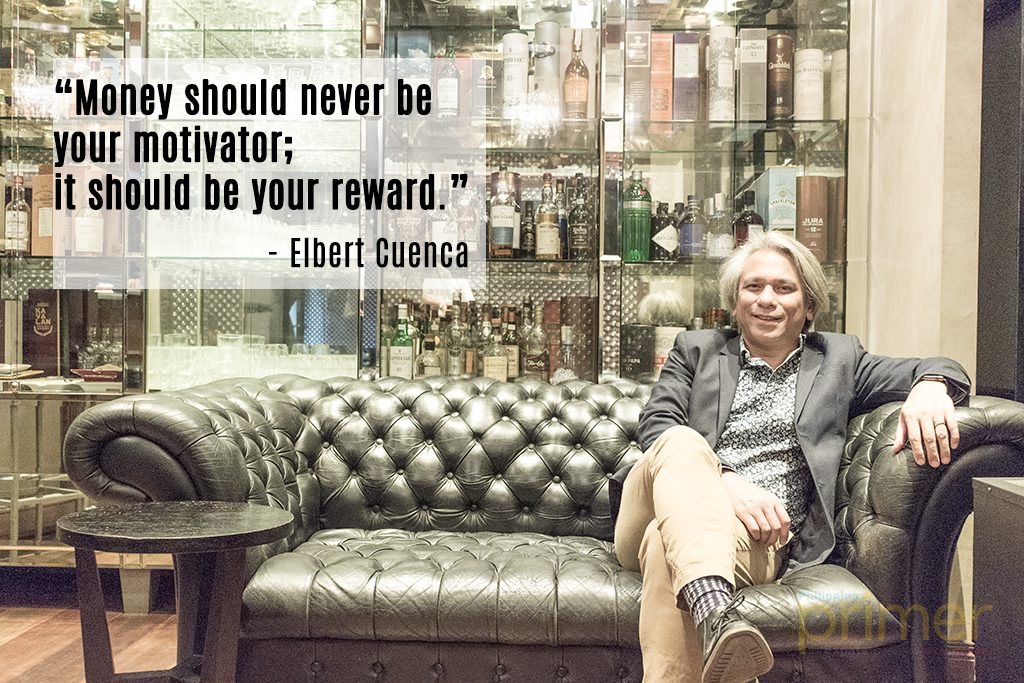
Can you give us a quote or a phrase that motivates you?
I guess it would be exactly what I said earlier. Money should never be your motivator, but it should rather be your reward.
A shorter version of this interview appears in the June 2018 issue of Philippine Primer English magazine.




